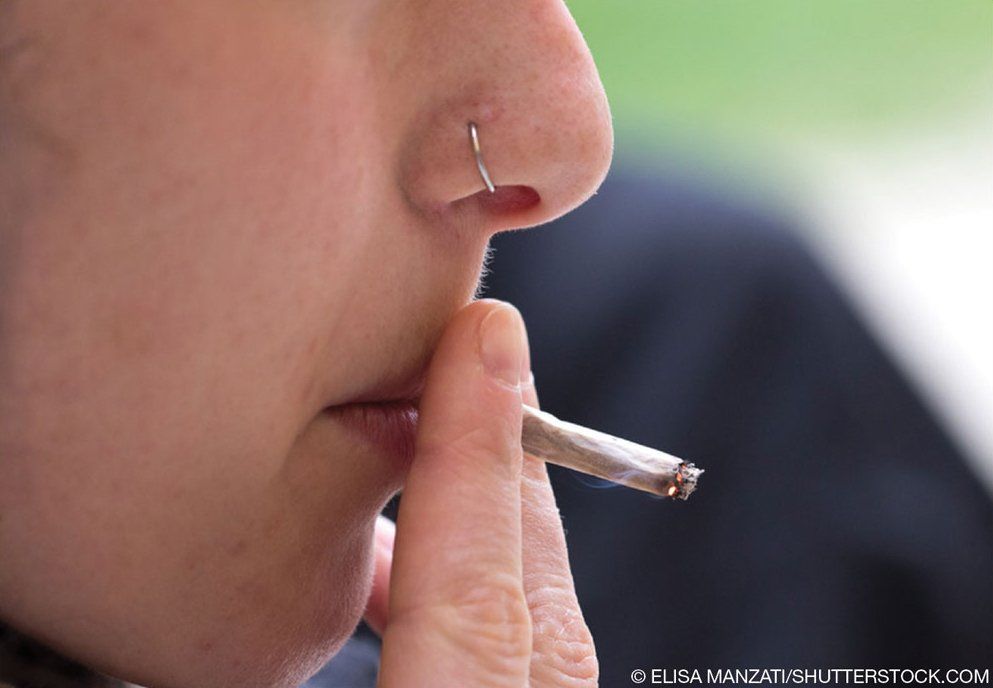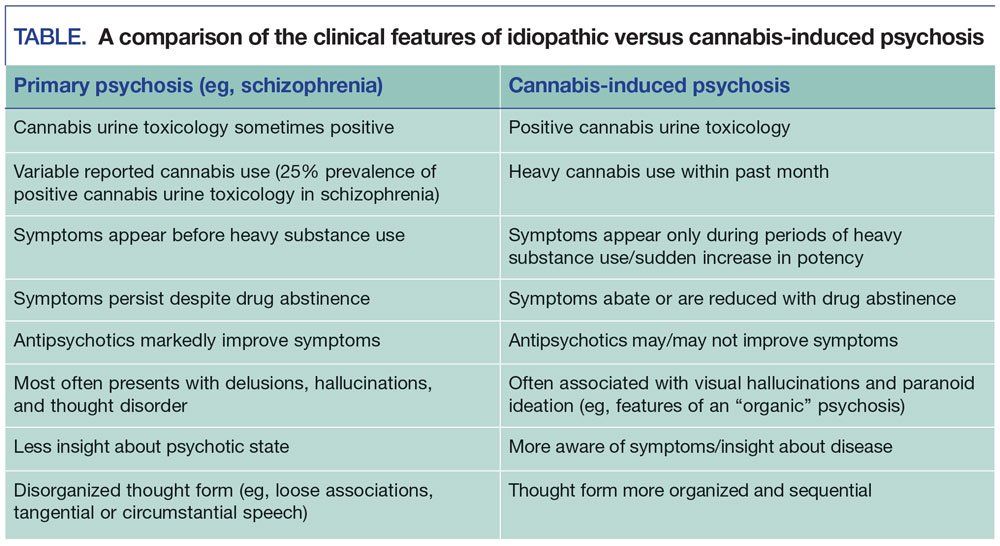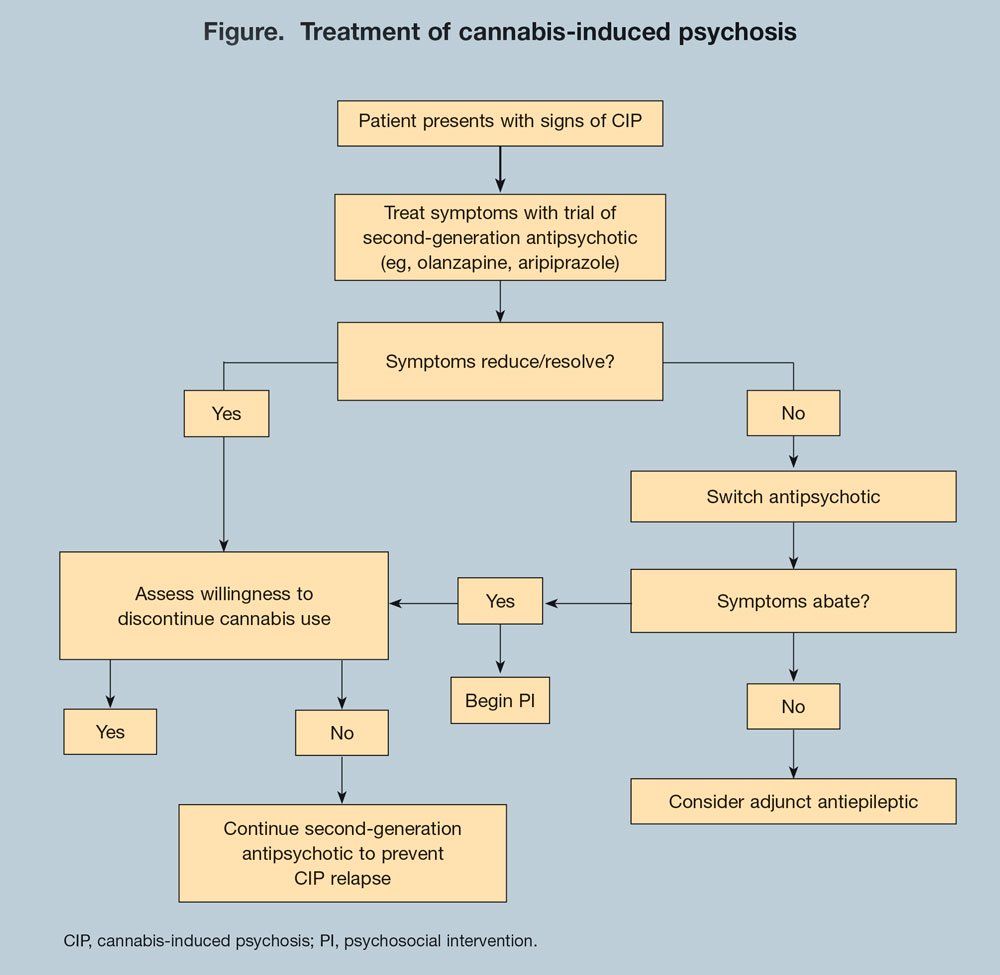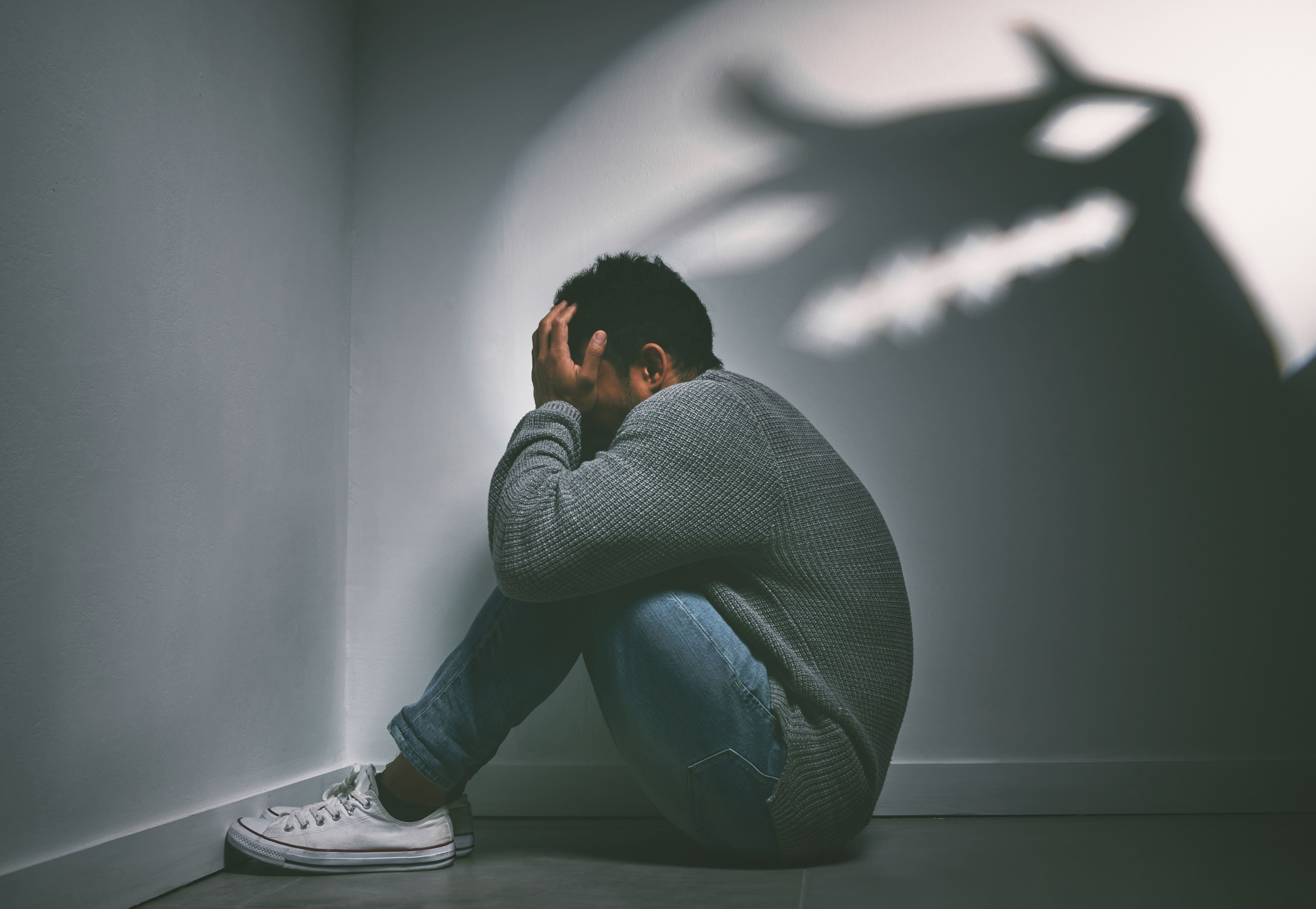Publication
Article
Psychiatric Times
Cannabis-Induced Psychosis: A Review
Author(s):
Numerous lines of evidence suggest a correlation between cannabis consumption and a variety of psychiatric conditions, including cannabis-induced psychosis.
© Elisa Manzati/shutterstock.com

TABLE. A comparison of the clinical features of idiopathic versus cannabis-induced psychosis

Figure. Treatment of cannabis-induced psychosis

Cannabis is the most widely used illicit drug in the United States, and trends show increasing use in the general population. As cannabis consumption rises, there has been significant emerging evidence for cannabis-related risks to health.1
Numerous lines of evidence suggest a correlation between cannabis consumption and a variety of psychiatric conditions, including cannabis-induced psychosis (CIP). While it can be difficult to differentiate CIP from other psychoses, CIP holds distinguishing characteristics, which may aid in its diagnosis. Given the increasing push toward cannabis legalization, assessing CIP and employing timely treatments is critical.
Specifically in youth, there is a direct relationship between cannabis use and its risks. The lack of knowledge surrounding its detrimental effects, combined with misunderstandings related to its therapeutic effects, has potential for catastrophic results.
CASE VIGNETTE
Ms. J, a 19-year-old college sophomore, was admitted to the Early Psychosis Unit at the Centre for Addiction and Mental Health (CAMH) displaying signs of agitation and acute psychosis. Her roommates had noted that her behavior had become increasingly bizarre, and she had isolated herself over the past month. She began smoking marijuana at the age of 17 and since starting college used it daily.
Ms. J exhibited signs of paranoia, believing other students in her dorm were stealing from her and trying to poison her. She remained adamant that all her problems were rooted in the competitive environment of the university and that smoking marijuana aided in keeping her sanity. In a sense, she was self-medicating. Her clinical presentation was consistent with a diagnosis of CIP.
After the hospitalization, she received outpatient case management services in the Early Psychosis Program at CAMH, which included motivational interviewing to raise her awareness about the importance of abstaining from cannabis use. She has been abstinent from cannabis for more than a year with no evidence of psychosis; she recently returned to school to finish her degree.
Related content: 8 Distinguishing Features of Primary Psychosis Versus Cannabis-Induced Psychosis
Epidemiology of CIP
Reports have shown a staggering increase in cannabis-related emergency department (ED) visits in recent years. In 2011, the Substance Abuse and Mental Health Services Administration (SAMHSA) and Drug Abuse Warning Network (DAWN) estimated a total of 1.25 million illicit-drug–related ED visits across the US, of which 455,668 were marijuana related.2 A similar report published in 2015 by the Washington Poison Center Toxic Trends Report showed a dramatic increase in cannabis-related ED visits.3 In states with recent legalization of recreational cannabis, similar trends were seen.4
States with medicinal marijuana have also shown a dramatic rise in cannabis-related ED visits. Moreover, states where marijuana is still illegal also showed increases.5 This widespread increase is postulated to be in part due to the easy accessibility of the drug, which contributes to over-intoxication and subsequent symptoms. Overall, from 2005 to 2011, there has been a dramatic rise in cannabis-related ED visits among all age groups and genders.
Neurobiology of CIP
Cannabis is considered an environmental risk factor that increases the odds of psychotic episodes, and longer exposure is associated with greater risk of psychosis in a dose-dependent fashion. The drug acts as a stressor that leads to the emergence and persistence of psychosis. While a number of factors play a role in the mechanism by which consumption produces psychosis, the primary psychoactive ingredient is considered to be delta 9-tetrahydrocannabinol (delta9-THC). Properties of delta9-THC include a long half-life (up to 30 days to eliminate the long-acting THC metabolite carboxy-THC from urine) and high lipophilicity, which may contribute to CIP.
During acute consumption, cannabis causes an increase in the synthesis and release of dopamine as well as increased reuptake inhibition, similar to the process that occurs during stimulant use. Consequently, patients with CIP are found to have elevated peripheral dopamine metabolite products.
Findings from a study that examined presynaptic dopaminergic function in patients who have experienced CIP indicate that dopamine synthesis in the striatum has an inverse relationship with cannabis use. Long-term users had reduced dopamine synthesis, although no association was seen between dopaminergic function and CIP.6 This observation may provide insight into a future treatment hypothesis for CIP because it implies a different mechanism of psychosis compared with schizophrenia. As cannabis may not induce the same dopaminergic alterations seen in schizophrenia, CIP may require alternative approaches-most notably addressing associated cannabis use disorder.
Polymorphisms at several genes linked to dopamine metabolism may moderate the effects of CIP. The catechol-o-methyltransferase (COMT Val 158Met) genotype has been linked to increased hallucinations in cannabis users.7 Homozygous and heterozygous genetic compositions (Met/Met, Val/Met, Val/Val) for COMT Val 158Met have been studied in patients with CIP and suggest that the presence of Val/Val and Val/Met genotypes produces a substantial increase in psychosis in relation to cannabis use. This suggests that carriers of the Val allele are most vulnerable to CIP attacks.
There has been much controversy surrounding the validity of a CIP diagnosis and whether it is a distinct clinical entity or an early manifestation of schizophrenia. In patients being treated for schizophrenia, those with a history of CIP had an earlier onset of schizophrenia than patients who never used cannabis.8 Evidence suggests an association between patients who have received treatment for CIP and later development of schizophrenia spectrum disorder. However, it has been difficult to distinguish whether CIP is an early manifestation of schizophrenia or a catalyst. Nonetheless, there is a clear association between the 2 disorders.
Assessment of CIP
DSM-5 categorizes cannabis-induced psychotic disorder as a substance-induced psychotic disorder. However, there are distinguishing characteristics of CIP that differentiate it from other psychotic disorders such as schizophrenia. Clear features of CIP are sudden onset of mood lability and paranoid symptoms, within 1 week of use but as early as 24 hours after use. CIP is commonly precipitated by a sudden increase in potency (eg, percent of THC content or quantity of cannabis consumption; typically, heavy users of cannabis consume more than 2 g/d). Criteria for CIP must exclude primary psychosis, and symptoms should be in excess of expected intoxication and withdrawal effects. A comparison of the clinical features of idiopathic psychosis versus CIP is provided in the Table.
When assessing for CIP, careful history taking is critical. Time of last drug ingestion will indicate if a patient’s psychotic symptoms are closely related to cannabis intoxication/withdrawal effects. While acute cannabis intoxication presents with a range of transient positive symptoms (paranoia, grandiosity, perceptual alterations), mood symptoms (anxiety), and cognitive deficits (working memory, verbal recall, attention), symptoms that persist beyond the effects of intoxication and withdrawal are better categorized as CIP, regardless of the route of administration (smoke inhalation, oral, intravenous). CIP has historically been associated with fewer negative symptoms than schizophrenia; however, without a clear timeline of use, distinguishing schizophrenia from CIP may prove difficult.
A diagnosis of primary psychosis (eg, schizophrenia) is warranted in the absence of heavy cannabis use or withdrawal (for at least 4 weeks), or if symptoms preceded onset of heavy use. The age at which psychotic symptoms emerge has not proved to be a helpful indicator; different studies show a conflicting median age of onset.
Clinical features of schizophrenia and CIP share many overlapping characteristics. However, compared with primary psychoses with concurrent cannabis abuse, CIP has been established to show more mood symptoms than primary psychosis. The mood symptom profile includes obsessive ideation, interpersonal sensitivity, depression, and anxiety. Of significance is the presence of social phobia: 20% of patients with CIP demonstrate phobic anxiety compared with only 3.8% of patients with primary psychosis with cannabis abuse.
Hypomania and agitation have also been found to be more pronounced in cases of CIP.9 Visual hallucinations are more common and more distinct in CIP than in other psychoses such as schizophrenia. Perhaps the most discriminating characteristic of CIP is awareness of the clinical condition, greater disease insight, and the ability to identify symptoms as a manifestation of a mental disorder or substance use. The presence of much more rapidly declining positive symptoms is another distinctive factor of CIP.
Finally, family history may help distinguish CIP from primary psychosis. Primary psychosis has a strong association with schizophrenia and other psychotic disorders in first- or second-degree relatives, whereas CIP has a weaker family association with psychosis.
Treatment of CIP
As with all substance-induced psychotic states, abstinence from cannabis may be the definitive measure to prevent recurrence. With limited research surrounding CIP, achieving symptomatic treatment during acute phases of CIP has proved to be difficult. The Figure suggests possible treatment progression for CIP.
Pharmacotherapeutic interventions include the second-generation antipsychotic drug olanzapine and haloperidol. While both are equally effective, their different adverse- effect profiles should be taken into consideration when treating a patient; olanzapine is associated with significantly fewer extrapyramidal adverse effects.
One report indicates that antipsychotics worsened the condition in some patients.10 Conventional antipsychotics failed to abate the symptoms of CIP in one 20-year old man. Trials of olanzapine, lithium, and haloperidol had little to no effect on his psychosis. Risperidone was tried but elicited temporal lobe epilepsy with auditory, somatic, and olfactory hallucinations. However, the use of valproate sodium markedly improved his symptoms and cognition, returning him to baseline.
Carbamazepine has also been shown to have rapid effects when used as an adjunct to antipsychotics.11 Use of anti-seizure medication in CIP treatment has been hypothesized to reduce neuroleptic adverse effects, resulting in better tolerance of antipsychotics.10,11 These results suggest the use of adjunctive antiepileptics should be considered in CIP treatment strategies, although further studies in a broad range of patients with CIP are needed.
Abstaining from cannabis is the most beneficial and effective measure for preventing future CIP events; however, it is likely to be the most difficult to implement. Psychosocial intervention has a significant impact on early-phase psychosis, and when the intervention is initiated plays a role in disease outcomes. A delay in providing intensive psychosocial treatment has been associated with more negative symptoms compared with a delay in administrating antipsychotic medication.12 Employing cannabis- focused interventions with dependent patients who present with first-episode psychosis can decrease use in a clinically meaningful way and subjectively improve patient quality of life.
Compared with the standard of care, motivational interviewing significantly increases number of days abstinent from cannabis and aids in decreasing short-term consumption.13 Patients who are treated with motivational interviewing in addition to standard of care (combination of antipsychotic medication, regular office-based psychiatric contact, psychoeducation) are reported to also have more confidence and willingness to reduce cannabis use.
Patients with CIP who are unwilling or unable to decrease cannabis consumption may be protected from psychotic relapse with aripiprazole (10 mg/d). Its use suppresses the reemergence of psychosis without altering cannabis levels. However, no direct comparison has been made with aripiprazole and other antipsychotics in treating CIP. Clearly, well-controlled large studies of putative treatments for CIP are needed.
Conclusions
As more countries and states approve legalization, and marijuana becomes more accessible, CIP and other cannabis-related disorders are expected to increase. Efforts should be made by physicians to educate patients and discourage cannabis use. Just as there was an era of ignorance concerning the damaging effects of tobacco, today’s conceptions about cannabis may in fact be judged similarly in the future. The onus is on psychiatrists to take an evidence-based approach to this increasing problem.
Disclosures:
Dr. Grewal is a recent MD graduate of Avalon University School of Medicine in Willemstad, Curaçao. Dr. George is Chief of Addictions at the Centre for Addiction and Mental Health (CAMH) and Professor and Director of the Division of Brain and Therapeutics in the Department of Psychiatry at the University of Toronto. Dr. George’s research is supported by the Canadian Institutes of Health Research (CIHR), the CAMH Foundation, and the National Institute on Drug Abuse (NIDA).
Dr. Grewal reports no conflict of interest concerning the subject matter of this article. Dr. George reports that he is a consultant to Novartis, the American College of Neuropsychology, and the Canadian Center for Substance Use and Addiction.
References:
1. Fischer B, Imtiaz Z, Rudzinski K, Rehm J. Crude estimates of cannabis-attributable mortality and morbidity in Canada–implications for public health focused intervention priorities. J Public Health. 2015;38:183-188.
2. Substance Abuse and Mental Health Services Administration, Center for Behavioral Health Statistics and Quality. The DAWN Report: Highlights of the 2011 Drug Abuse Warning Network (DAWN) Findings on Drug-Related Emergency Department Visits. Rockville, MD; February 22, 2013.
3. Washington Poison Center. Toxic Trends Report: 2015 Annual Cannabis Report. http://www.wapc.org/toxic-trends/marijuana-and-you/2015annualcannabisreport/. Accessed June 9, 2017.
4. Kim HS, Monte AA. Colorado cannabis legalization and its effect on emergency care. Ann Emerg Med. 2016;68:71-75.
5. Brauser D. Cannabis-related ED visits rise in states with legalized use. Medscape. December 16, 2014. http://www.medscape.com/viewarticle/836663. Accessed June 9, 2017.
6. Bloomfield MA, Morgan CJ, Egerton A, et al. Dopaminergic function in cannabis users and its relationship to cannabis-induced psychotic symptoms. Biol Psychiatry. 2014;75:470-478.
7. Henquet C, Rosa A, Delespaul P, et al. COMT Val158Met moderation of cannabis-induced psychosis: a momentary assessment study of ‘switching on’ hallucinations in the flow of daily life. Acta Psychiatr Scand. 2009;119:156-160.
8. Arendt M, Rosenberg R, Foldager L, et al. Cannabis-induced psychosis and subsequent schizophrenia-spectrum disorders: follow-up study of 535 incident cases. Br J Psychiatry. 2005;187:510-515.
9. Rottanburg D, Robins AH, Ben-Arie O, et al. Cannabis-associated psychosis with hypomanic features. Lancet. 1983;320:1364-1366.
10. Perera T, Webler R. Cannabis-induced psychosis and an antipsychotic-induced seizure: a case report. Prim Care Companion CNS Disord. 2017;19(1). doi: 10.4088/PCC.16l01993.
11. Leweke F, Emrich M, Hinderk M. Carbamazepine as an adjunct in the treatment of schizophrenia-like psychosis related to cannabis abuse. Int Clin Psychopharmacol. 1999;14:37-39.
12. de Haan L, Linszen DH, Lenior ME, et al. Duration of untreated psychosis and outcome of schizophrenia: delay in intensive psychosocial treatment versus delay in treatment with antipsychotic medication. Schizophr Bull. 2003;29:341-348.
13. Bonsack C, Gibellini Manetti S, Favrod J, et al. Motivational intervention to reduce cannabis use in young people with psychosis: a randomized controlled trial. Psychother Psychosom. 2011;80:287-297.






